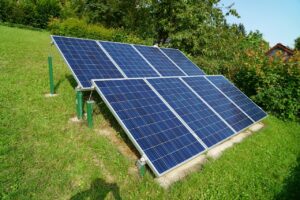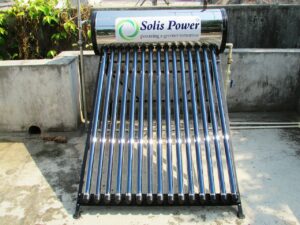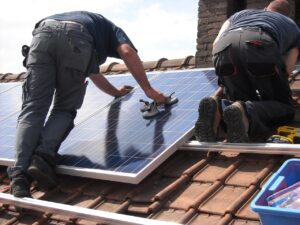Table of Contents
- Exploring the Key Advantages and Disadvantages of Solar Energy
- Understanding What Solar Energy Is
- Easily Set Up Your Solar Lighting Solutions
- Discover the Major Benefits of Solar Energy
- Why Solar Energy Is the Ultimate Solution for Your Home's Green Energy Needs
- Comprehensive Guide to Home Solar Battery Systems
- Effective Methods to Store Solar Energy in Your Home
- Heating Your Pool Efficiently with Solar Panels
- Analyzing the Pros and Cons of Nuclear Energy
- Recognizing the Benefits of Nuclear Energy
- Understanding the Mechanism Behind Solar Panels
- Impact of Reduced Sunlight on Solar Energy Production
- Evaluating the Advantages and Disadvantages of Wind Energy
- Exploring the Benefits of Wind Energy
- Weighing the Pros and Cons of Hydropower
Exploring the Key Advantages and Disadvantages of Solar Energy
When considering the installation of solar panels for your residence, it is crucial to evaluate the benefits and drawbacks of solar energy. This analysis plays a significant role in the decision-making process for homeowners. Among the prominent advantages is the potential for significant energy savings, while some challenges include the initial investment and space requirements. Understanding these aspects can help homeowners make informed choices about integrating solar energy into their lives.
The solar watt energy manager serves as an advanced control device that optimizes both energy production and consumption within a household. This intelligent system not only facilitates effective energy generation but also ensures efficient energy usage, providing significant benefits to homeowners. Its ability to monitor and manage energy flow is crucial for maximizing the advantages of solar energy, ultimately leading to reduced energy bills and enhanced sustainability.
The debate surrounding nuclear energy is fueled by both its supporters and critics, each passionately advocating their stance. Acknowledging the pros and cons of nuclear power is essential for individuals looking to make educated decisions about their energy consumption. This understanding is particularly important given the complexities involved in transitioning to various energy sources. By weighing these factors, you can better evaluate how nuclear energy fits into the broader landscape of renewable energy options.
While the application of solar energy may seem straightforward, there are logistical challenges to consider. Space limitations can hinder the installation of solar panels, especially for residential properties that may lack adequate roof space or yard area. Those living in apartments or condos may find it impractical to set up their own solar array, as such decisions often rest with the property management. Therefore, assessing your available space is vital before making a commitment to solar energy.
One of the significant advantages of solar energy is its contribution to eco-friendly building practices, encouraging a shift towards renewable energy sources like solar, wind, and geothermal. This transition helps to decrease reliance on traditional energy systems, thereby minimizing carbon footprints. However, the location of your solar system is critical; environmental factors such as nearby trees or buildings can obstruct sunlight, limiting energy production. Architectural design may also influence the feasibility of solar panels, as certain structures may not be well-suited for solar installation.
Recent reports indicate that Vietnam is planning to lower feed-in tariffs for rooftop solar installations by as much as 38% in order to alleviate pressure on its power grid. According to the Dai Doan Ket newspaper, Hoang Tien Dung, the head of the Ministry of Industry and Trade’s Electricity and Renewable Energy Bureau, stated that tariffs will be reduced to a range of US$0.052 to US$0.058 per kilowatt-hour, depending on system size. This adjustment may affect the financial viability of solar investments in the region.
If you're examining your recent energy bills and identifying opportunities for improvement, consider the vast potential of solar energy. By harnessing the sun's power, you can significantly reduce your reliance on the grid or even achieve energy independence. Moreover, the long-term maintenance costs associated with solar systems are relatively low, contributing to their appeal for homeowners looking for sustainable energy solutions.
Easily Set Up Your Solar Lighting Solutions
Whether you're utilizing solar energy in your recreational vehicle, at a campsite, or through a fixed installation at home, the versatility of solar energy devices is a significant advantage. Many solar products, such as solar lanterns and decorative fairy lights, can be easily transported, making them ideal for various settings. Additionally, investing in portable solar panels and batteries enhances the mobility and adaptability of your solar-powered system, allowing you to enjoy the benefits of solar energy wherever you go.
The Suaoki solar generator stands out as a highly regarded option, offering excellent value for its price and straightforward setup. It features three charging options, enabling you to charge it outdoors using the Suaoki 60W solar panel or any compatible solar panel at home. With a battery capacity of 444Wh, this portable generator is lightweight, weighing just over 12 pounds, making it perfect for camping trips, fishing excursions, and construction sites.
For families looking to engage children in fun educational activities, there are numerous exciting solar projects that can be easily implemented at home. One creative idea involves building a solar cooker that uses the sun's rays to prepare meals. On particularly hot days, you can design an oven capable of cooking pizza, hot dogs, or nachos. This hands-on project not only teaches kids about solar energy but also provides a delicious meal to enjoy.
A recent project involving solar lighting presented challenges for a client who required effective lighting for multiple areas, including car parks and a nearby construction site. Traditional lighting solutions, which often required extensive planning and installation, proved cumbersome. However, the introduction of portable solar lights, which can be easily transported using forklifts, transformed the situation, ensuring that both the car parks and construction areas were well-lit without the hassle of permanent installations. This exemplifies the advantages of adopting solar technology over traditional lighting methods.
Discover the Major Benefits of Solar Energy
In navigating the world of solar energy, it's essential to differentiate between accurate information and the harmful misconceptions that often circulate. This article aims to illuminate the primary advantages and disadvantages of solar panel installation and the solar energy industry as a whole. The benefits of adopting solar energy extend beyond individual households to encompass broader financial, social, and environmental implications. While many advantages are widely recognized, there are also lesser-known benefits that we will explore in detail throughout this discussion.
Overall, solar energy presents substantial advantages that outweigh its drawbacks, making it one of the most accessible forms of renewable energy available globally. From residential homes to commercial enterprises, solar energy offers opportunities to reduce electricity costs and diversify energy sources, which is especially vital during potential emergencies. As technology evolves, solar energy becomes increasingly efficient and affordable, facilitating wider adoption among homeowners and businesses alike.
For those interested in hydropower, several engaging videos featuring experts discuss the pros and cons of this renewable energy source. While some environmental activists voice concerns about dam construction, it's essential to consider the long-term viability of hydropower. Will we prioritize renewable energy sources like solar, or continue relying on fossil fuels? These questions are critical as we weigh the future of energy generation.
The hi-mo3 half-cut bifacial PERC module series has emerged as a leader in monocrystalline PERC technology, boasting high power, efficiency, and low capital expenditure. By utilizing half-cut technology, the operational current of the cells is reduced, minimizing resistive losses and increasing power output by an average of 5-10 watts. The bifacial design allows the module’s front panel to reach 320W (60-cell), with a bifaciality rating exceeding 75%.

Why Solar Energy Is the Ultimate Solution for Your Home's Green Energy Needs
When it comes to choosing a green energy source, solar energy stands out as a premier option. It generates electricity through solar panels that harness the sun's energy, converting it into usable power for homes and businesses. While there are various renewable energy sources available, solar energy's growing popularity is evident as more systems are being installed across residential and commercial properties. Solar panels, being static and devoid of moving parts, offer a reliable and efficient energy solution.
Comprehensive Guide to Home Solar Battery Systems
Every homeowner should have the opportunity to install solar energy systems on their property. In several states, this right is supported by solar access laws designed to prevent local governments and homeowners’ associations (HOAs) from obstructing solar energy use. Unfortunately, these legal protections are not universally implemented. Even in areas with supportive legislation, some HOAs may cling to outdated policies that hinder homeowners’ access to solar technology and propagate myths regarding aesthetics and property values. This guide aims to provide strategies for overcoming HOA objections and ensuring your home is solar-friendly.
While solar energy offers numerous benefits, it also comes with certain challenges. If you find the content of this article intriguing and wish to learn more, consider our 6-step guide focused on helping you select the best solar panels for your home. This comprehensive resource covers essential topics, including roof suitability, solar panel types, costs, savings potential, and maintenance requirements.
For those interested in battery backup solutions, SolarCity provides Tesla Powerwall batteries, which offer reliable power backup for homeowners during outages and emergencies. The compact and stackable design of the Powerwall integrates seamlessly with SolarCity’s solar systems, featuring a built-in inverter for added convenience.
Historically, energy storage has been a significant hurdle for solar energy systems. Despite advancements in solar production technology, battery technology has lagged behind, creating challenges in effectively storing excess energy for use during nighttime or cloudy conditions. The ability to efficiently store energy remains a focal point for enhancing the overall viability of solar energy systems.
Effective Methods to Store Solar Energy in Your Home
Solar energy is widely recognized as the most efficient way to generate renewable energy for buildings. Its affordability, ease of installation, and minimal maintenance requirements make it an attractive option for homeowners. However, it's essential to understand that solar energy may not be suitable in every scenario. As with any energy source, there are pros and cons to consider. When contemplating solar energy for your home, it’s beneficial to look beyond the marketing rhetoric and examine the facts.
The sun emits an enormous amount of energy, with just a fraction of it reaching Earth in approximately 8 minutes. Each hour, the Earth receives enough solar energy to meet global energy demands for an entire year—an impressive statistic that showcases the potential of solar energy.
As you consider how to harness this abundant energy for your home, solar panels emerge as the primary solution.
The Solar Power Portal Awards for 2018 are now open for entries, as announced by Clean Energy News. These awards have become a highlight of the UK renewables industry calendar, now in their sixth year, featuring a rebranding that unites sister publications Solar Power Portal and Energy Storage News to celebrate the thriving battery storage market both domestically and internationally.
Distributed energy generation, such as solar and wind, offers enhanced efficiency and reduced waste compared to centralized generation, as the energy producers are situated closer to the consumers. This model of energy generation is feasible and effective for harnessing renewable sources, with smaller microgrid units demonstrating reliability, as they are less likely to fail simultaneously compared to larger units. Additionally, the impact of failure in smaller systems is less severe than in larger installations.
Heating Your Pool Efficiently with Solar Panels
Solar energy extends beyond just photovoltaic panels; it also encompasses solar water heaters, which are commonly utilized for heating and storing water in cooler climates. Using solar thermal collectors, these heaters absorb sunlight to generate heat, providing efficient hot water solutions during sunny days. The effectiveness of solar water heaters depends on sunlight availability, making them a reliable option for meeting warm water demands.
Various types of solar systems can be implemented to heat water, with thermal solar being a more environmentally friendly alternative to conventional gas boilers and heaters. Additionally, there are exciting solar science kits available for children, showcasing fun and educational solar-powered toys. The scalability of solar technology has led to the proliferation of miniature solar-powered products, which not only serve educational purposes but also offer enjoyment.
One of the most commonly used solar technologies today includes solar water heaters and pool heaters, both operating on the same fundamental principles. While many people associate solar energy primarily with solar panels, thermal solar solutions are often the most economical way to begin incorporating solar energy into daily life.
Solar panels are designed not only to reduce energy bills but also to power a variety of household appliances. They can control pool and shower heaters, as well as charge devices like phones, radios, and laptops. The versatility of solar energy is indeed remarkable, with an impressive array of products it can power.
Analyzing the Pros and Cons of Nuclear Energy
In today's world, the pursuit of green and renewable energy sources is more crucial than ever. The primary method for many individuals to access clean energy is through solar panels. However, like any other energy source, installing solar panels comes with its own set of advantages and disadvantages that merit consideration. This article will delve into the benefits and challenges associated with solar panel installation.
As with most renewable energy sources, solar energy systems present both advantages and challenges. Some notable downsides include:
the high initial costs of equipment—while solar energy can lead to reduced electric bills, the upfront investment for panels and installation can exceed $20,000. Additionally, powering devices that operate on direct current may incur extra expenses.
Nuclear power plants are established through a multi-step process designed to harness energy while containing its negative byproducts. This process encompasses both advantages and disadvantages associated with this energy source.
Though solar energy has its challenges, extensive research is needed to enhance this technology for broader adoption. The pressing concern remains the unsustainable nature of fossil fuel usage. While solar power has its disadvantages, they pale in comparison to the detrimental effects associated with fossil fuel consumption. Therefore, the focus should be on addressing the shortcomings of solar energy rather than abandoning it entirely. As technology improves and careful planning is implemented, a sustainable energy future is achievable.
Recognizing the Benefits of Nuclear Energy
Despite its controversies and potential drawbacks, nuclear energy offers several advantages compared to other energy production methods. It is known for being low-cost, reliable, and emitting minimal greenhouse gases.
Various methods exist for generating electric power from diverse energy sources, including solar, thermal, wind, and nuclear energy. This article will explore solar energy, highlighting its benefits and disadvantages associated with solar energy systems for electric power generation.
One reason nuclear energy often faces scrutiny is due to its numerous disadvantages, including uranium mining, water pollution, waste management, leaks, and the risk of reactor failures.
With a complex balance of benefits and drawbacks, it’s no surprise that nuclear power remains one of the most debated energy sources. Educating yourself on this topic is essential for forming an informed opinion regarding its use.
Understanding the Mechanism Behind Solar Panels
Many electricity providers offer buy-back programs for surplus energy generated by solar panels and other home appliances. Favorable buy-back rates enable homeowners to recoup their initial investments and, in some cases, even profit from their solar systems. Moreover, the maintenance costs associated with solar panels are relatively low. Once the installation is complete, most expenses are upfront, alleviating concerns about ongoing, expensive maintenance.
The installation of rooftop solar panels involves placing a mounting system, commonly referred to as a “rack,” on your roof. However, certain roofing materials, particularly those found in older or historic homes, such as slate or cedar tiles, can pose challenges for solar installers. Furthermore, many residences and apartment buildings may feature skylights or other roof structures that complicate installation, potentially increasing costs. Nonetheless, these challenges should not hinder the widespread adoption of solar energy in the United States.
G&H Sustainability has garnered attention for its innovative approach in delivering groundbreaking projects, like the one for Asda. This project, which involved a significant investment of £7 million for supermarkets on Abbey Lane in Leicester, has been shortlisted for a prestigious national award in the Commercial Rooftop category of the 2014 Solar Power Portal Awards. The initiative included the installation of 984 photovoltaic panels utilizing an innovative mounting system to ensure optimal solar exposure.
SolarCity’s solar panels are designed to outlast many competitors, boasting a 10-year longevity advantage due to rigorous testing that exceeds industry standards. Their systems feature integrated front skirts, diverted vents, and concealed clamps for a polished appearance. Additionally, SolarCity covers all roof work and system repairs at no extra charge, ensuring peace of mind for homeowners.
Impact of Reduced Sunlight on Solar Energy Production
Solar panels are designed to capture sunlight and convert it into usable electricity for homes, buildings, or swimming pools. The core component of a solar panel is the photovoltaic cell, which effectively transforms the sun's energy into electrical power.
The city of Orlando, Florida, has committed to achieving carbon neutrality in its government operations by the year 2030. This ambitious plan includes transitioning its vehicle fleet to 100% renewable energy and targeting a 50% reduction in overall energy consumption. Presently, Orlando has implemented solar water heaters in two facilities and is in the process of adding them in another location. The city has successfully installed 5.7 MW of new solar capacity to meet its energy needs. Moreover, a solar farm with a capacity of 108.5 megawatts is under development, aiming to be operational by the end of the year. In 2020, a 20 MW floating solar array and two additional solar initiatives are also in the works.
It's essential to discuss the advantages and disadvantages of the solar water heating system with a thermosiphon in terms of energy and performance balance. How would the energy/power performance of this system alter if we were to double the size of the accumulator and the solar simulator/collector?






Comments are closed